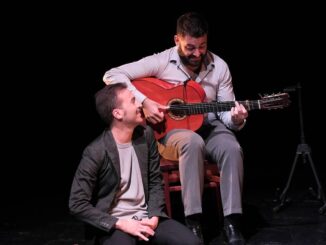 Metamoto takes its name from the collision of two words: “meta,” meaning beyond, and “con moto,” a composer’s term instructing musicians to play “with motion.” It was a smart title for a night that integrated dance and music as equals. The program, curated by Lydia Bittner-Baird, included Requiem for a Mustard Seed Closes in Song, Take 2, a pairing between choreographer Letty Bassart, and composer Daniel Bernard Roumain, and Set by choreographer Yara Travieso and composer Jerome Begin.
Metamoto takes its name from the collision of two words: “meta,” meaning beyond, and “con moto,” a composer’s term instructing musicians to play “with motion.” It was a smart title for a night that integrated dance and music as equals. The program, curated by Lydia Bittner-Baird, included Requiem for a Mustard Seed Closes in Song, Take 2, a pairing between choreographer Letty Bassart, and composer Daniel Bernard Roumain, and Set by choreographer Yara Travieso and composer Jerome Begin.
A choreographer’s approach to the relationship between music and dance in some ways defines his or her creative alliances. Contemporary dance tends to split music apart from movement. On the other hand, many dance styles – from hip-hop to flamenco – are so tightly bound to rhythm that one does not wholly exist without the other. Metamoto took a bold position in the dance/music debate by giving both components full and equal artistic identity.
In Miami’s new spacious and acoustically glorious symphony hall, the musicians were well-lit and visibly positioned on stage with the dancers, and their rich and resonant sounds were so intricate and compelling, with such dramatic shifts, that the music alone could have absorbed the audience’s attention for the entire night. For Requiem, Bassart selected and rearranged excerpts from a string quartet composed by Daniel Bernard Roumain. Her choreography reflected the pathos of the music, deeply articulating a mournful tone. For Set, Travieso and composer Jerome Begin worked closely from the beginning, producing a tight interlock of crescendos and full stops.
Requiem and Set made sense as a pair. Both choreographies were set on five dancers undefined by hierarchies, like an organism with different parts. Monotone costumes generalized the dancers’ forms almost to the point of androgyny. In Requiem they wore plain black clothes and, for Set, formfitting fleshy nude.
Requiem would be the organism’s psychological or emotional state: different aspects of the self-coping with grief or loss of some kind. Black costumes and umbrellas brought to mind a scene from a funeral, and the dancers moved in self-effacing or self-destructive patterns. They hid behind the umbrellas, slid on the floor face down, and pulled themselves into contracted positions. Sometimes one dancer carried another into partial flight.
Set was more like a fantastic voyage into an organism’s nervous system. The bodies of the dancers assembled and swirled like a collection of cells. Set opened with a remarkable tower of amorphous, headless bodies with one rapturous being on top who was the consciousness of the whole. She was trying to orient the organism in some way. The New World Symphony’s round Gehry architecture translated into walls of a bodily organ, a stomach, say, and music gurgled and swelled in ways that literally resonated in the body. This organism seemed diseased, as some rogue parts broke off, flailing on the floor or attacking the others.
Travieso’s Set went too far in the wrong direction when one dancer and then another heaved full-body, covering their mouths as if to hold back vomit. The natural response to watching this moment was to become physically nauseous in empathy. It’s hard-wired into our systems. No surprise, I felt sick for the rest of the night. It’s hard to think of a justification for imposing nausea on the bodies of the audience – a line has to be drawn somewhere.


Be the first to comment